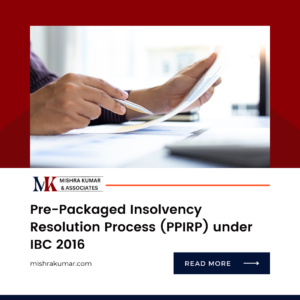Guiding Insolvency Professionals Through the Corporate Insolvency Resolution Process (CIRP)
The Corporate Insolvency Resolution Process (CIRP) is a critical mechanism under the Insolvency and Bankruptcy Code (IBC) in India. It is designed to resolve financial distress faced by companies and to protect the interests of creditors and stakeholders. In this blog, we will explore the importance of assistance in carrying out the CIRP and how professionals play a crucial role in guiding insolvency professionals through this complex process.
INTRODUCTION
The Corporate Insolvency Resolution Process (CIRP) is a critical mechanism under the Insolvency and Bankruptcy Code (IBC) in India. It is designed to resolve financial distress faced by companies and to protect the interests of creditors and stakeholders. In this blog, we will explore the importance of assistance in carrying out the CIRP and how professionals play a crucial role in guiding insolvency professionals through this complex process.
ANALYSIS
Understanding the Corporate Insolvency Resolution Process (CIRP)
Before we delve into the role of assistance, let’s clarify what the CIRP entails:
CIRP: The CIRP is a time-bound process aimed at reviving the financially distressed company or facilitating its orderly liquidation. It is initiated when a company defaults on its debt obligations and is admitted to insolvency proceedings.
Insolvency Professionals: Insolvency professionals are licensed practitioners responsible for managing the CIRP. They play a central role in the process, working to maximize the value of the company’s assets for the benefit of creditors.
Importance of Assistance in CIRP
Why is assistance crucial for insolvency professionals in carrying out the CIRP?
Legal and Procedural Expertise: The CIRP is governed by complex legal and procedural requirements. Professionals with expertise in insolvency laws can guide insolvency professionals through the process to ensure compliance and avoid legal pitfalls.
Operational Support: Managing a distressed company involves various operational challenges, such as assessing the financial health, negotiating with creditors, and identifying potential buyers. Assistance from financial and operational experts can prove invaluable.
Stakeholder Communication: Effective communication with creditors, shareholders, and other stakeholders is essential during the CIRP. Professionals assist in building consensus and managing expectations.
Financial Planning: Crafting a resolution plan that balances the interests of creditors and the distressed company requires financial acumen. Professionals can help in financial modeling and planning.
Compliance and Reporting: Regulatory compliance and reporting are critical aspects of the CIRP. Professionals assist in preparing the necessary reports and filings to meet regulatory requirements.
Part 3: The CIRP Assistance Process
The assistance process for insolvency professionals generally involves the following steps:
Assessment: Professionals assess the financial condition of the distressed company, including its assets, liabilities, and operational challenges.
Strategy Development: A strategic plan is developed, outlining the steps and actions needed to navigate the CIRP successfully.
Execution: The plan is executed, involving negotiations with creditors, resolution applicants, and other stakeholders.
Compliance and Reporting: Professionals ensure that all regulatory and legal requirements are met, including the submission of necessary reports and documents.
Stakeholder Engagement: Effective communication and engagement with stakeholders are maintained throughout the process to build consensus and cooperation.
CONCLUSION
The Corporate Insolvency Resolution Process (CIRP) is a critical tool for addressing financial distress in companies. Assistance from professionals is instrumental in guiding insolvency professionals through the complexities of the CIRP.
As the Indian insolvency landscape continues to evolve, the role of professionals in providing expertise, operational support, and compliance guidance remains indispensable in achieving successful resolutions and maximizing value for creditors and stakeholders.
FAQs
Q1: What is the role of insolvency professionals in the CIRP?
A1: Insolvency professionals are responsible for managing the CIRP, including assessing the company’s financial health, negotiating with creditors, developing resolution plans, and ensuring compliance with legal and regulatory requirements.
Q2: Can a distressed company choose its own insolvency professional?
A2: In most cases, the appointment of an insolvency professional is based on the recommendations of financial creditors. The insolvency professional is selected from a panel of professionals registered with insolvency professional agencies.
Q3: How long does the CIRP typically last?
A3: The CIRP is intended to be completed within 180 days, with a possible extension of up to 90 days. However, in complex cases, the process may take longer.
RECENT POSTS
- The implication of Stamp Duty on Scheme of Arrangement (Merger & Amalgamation):
- Pre-Packaged Insolvency Resolution Process (PPIRP) under IBC 2016
- BUY BACK OF SHARES V/S DIVIDEND
- Comprehensive comparative analysis of SEBI (Listing Obligations and Disclosure Requirements) (Second Amendment) Regulations, 2021.
- SEBI (Delisting of Equity Shares) Regulations, 2021-Imposes new responsibilities on the board of directors.

The implication of Stamp Duty on Scheme of Arrangement (Merger & Amalgamation):
The implication of Stamp Duty on Scheme of Arrangement (Merger & Amalgamation): The Scheme of Arrangement is a legal mechanism under corporate law that allows

Pre-Packaged Insolvency Resolution Process (PPIRP) under IBC 2016
Pre-Packaged Insolvency Resolution Process (PPIRP) under IBC 2016 The Insolvency and Bankruptcy Code (IBC) 2016, is a comprehensive legislation aimed at consolidating and amending laws

BUY BACK OF SHARES V/S DIVIDEND
BUY-BACK OF SHARES V/S DIVIDEND A dividend offers cash rewards to all shareholders in accordance with their stake in the company, whereas a share buyback

Comprehensive comparative analysis of SEBI (Listing Obligations and Disclosure Requirements) (Second Amendment) Regulations, 2021.
Comprehensive comparative analysis of SEBI (Listing Obligations and Disclosure Requirements) (Second Amendment) Regulations, 2021. Securities and Exchange Board of India (“SEBI”) vide notification dated May

SEBI (Delisting of Equity Shares) Regulations, 2021-Imposes new responsibilities on the board of directors.
SEBI (Delisting of Equity Shares) Regulations, 2021-Imposes new responsibilities on the board of directors. Securities and Exchange Board of India (“SEBI”) vide notification dated 10th

Summary of Insolvency and Bankruptcy Board of India (Liquidation Process) (Amendment) Regulations, 2024
Summary of Insolvency and Bankruptcy Board of India (Liquidation Process) (Amendment) Regulations, 2024 The Insolvency and Bankruptcy Board of India (IBBI) recently issued amendments to

